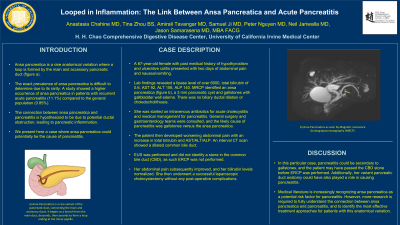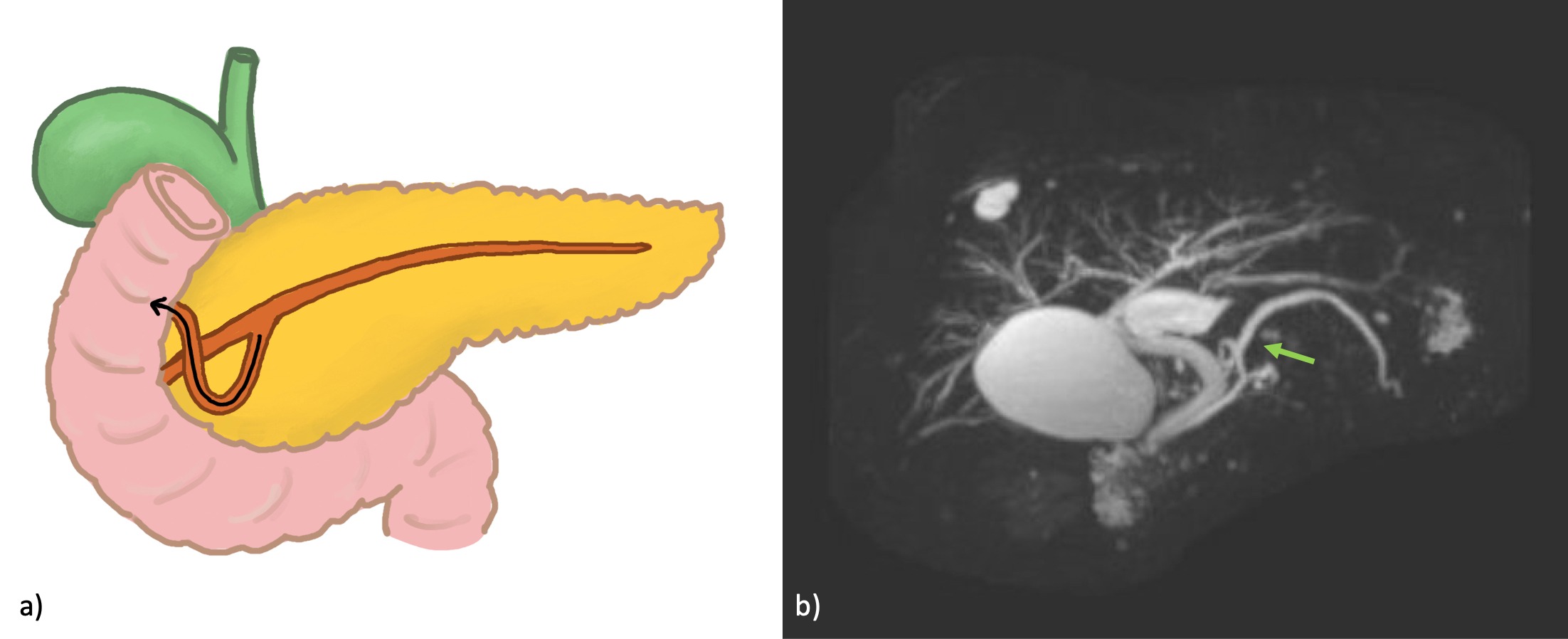Tuesday Poster Session
Category: Biliary/Pancreas
P2998 - Looped in Inflammation: The Link Between Ansa Pancreatica and Acute Pancreatitis
Tuesday, October 24, 2023
10:30 AM - 4:00 PM PT
Location: Exhibit Hall

Has Audio

Anastasia Chahine, MD
University of California Irvine
Orange, CA
Presenting Author(s)
Award: Presidential Poster Award
Anastasia Chahine, MD, Tina Zhou, BS, Amirali Tavangar, MD, Samuel Ji, MD, Peter Nguyen, MD, Neil Jariwalla, MD, Jason Samarasena, MD
University of California Irvine, Orange, CA
Introduction: Ansa pancreatica is a rare anatomical variation where a loop is formed by the main and accessory pancreatic duct (figure a). The exact prevalence of ansa pancreatica is difficult to determine due to its rarity. A study showed a higher occurrence of ansa pancreatica in patients with recurrent acute pancreatitis (11.1%) compared to the general population (0.85%). The connection between ansa pancreatica and pancreatitis is hypothesized to be due to potential ductal obstruction, leading to pancreatic inflammation. We present here a case where ansa pancreatica could potentially be the cause of pancreatitis.
Case Description/Methods: A 67-year-old female with past medical history of hypothyroidism and ulcerative colitis presented with two days of abdominal pain and nausea/vomiting. Lab findings revealed a lipase level of over 6000, total bilirubin of 0.6, AST 92, ALT 106, ALP 140. MRCP identified an ansa pancreatica (figure b), a 3 mm pancreatic cyst and gallstones with gallbladder wall edema. There was no biliary ductal dilation or choledocholithiasis. She was started on intravenous antibiotics for acute cholecystitis and medical management for pancreatitis. General surgery and gastroenterology teams were consulted, and the likely cause of pancreatitis was gallstones versus the ansa pancreatica. The patient then developed worsening abdominal pain with an increase in total bilirubin and AST/ALT/ALP. An interval CT scan showed a dilated common bile duct. EUS was performed and did not identify a stone in the common bile duct (CBD), as such ERCP was not performed. Her abdominal pain subsequently improved, and her bilirubin levels normalized. She then underwent a successful laparoscopic cholecystectomy without any post-operative complications.
Discussion: In this particular case, pancreatitis could be secondary to gallstones, and the patient may have passed the CBD stone before ERCP was performed. Additionally, her variant pancreatic duct anatomy could have also played a role in causing pancreatitis. Medical literature is increasingly recognizing ansa pancreatica as a potential risk factor for pancreatitis. However, more research is required to fully understand the connection between ansa pancreatica and pancreatitis, and to identify the most effective treatment approaches for patients with this anatomical variation.

Disclosures:
Anastasia Chahine, MD, Tina Zhou, BS, Amirali Tavangar, MD, Samuel Ji, MD, Peter Nguyen, MD, Neil Jariwalla, MD, Jason Samarasena, MD. P2998 - Looped in Inflammation: The Link Between Ansa Pancreatica and Acute Pancreatitis, ACG 2023 Annual Scientific Meeting Abstracts. Vancouver, BC, Canada: American College of Gastroenterology.
Anastasia Chahine, MD, Tina Zhou, BS, Amirali Tavangar, MD, Samuel Ji, MD, Peter Nguyen, MD, Neil Jariwalla, MD, Jason Samarasena, MD
University of California Irvine, Orange, CA
Introduction: Ansa pancreatica is a rare anatomical variation where a loop is formed by the main and accessory pancreatic duct (figure a). The exact prevalence of ansa pancreatica is difficult to determine due to its rarity. A study showed a higher occurrence of ansa pancreatica in patients with recurrent acute pancreatitis (11.1%) compared to the general population (0.85%). The connection between ansa pancreatica and pancreatitis is hypothesized to be due to potential ductal obstruction, leading to pancreatic inflammation. We present here a case where ansa pancreatica could potentially be the cause of pancreatitis.
Case Description/Methods: A 67-year-old female with past medical history of hypothyroidism and ulcerative colitis presented with two days of abdominal pain and nausea/vomiting. Lab findings revealed a lipase level of over 6000, total bilirubin of 0.6, AST 92, ALT 106, ALP 140. MRCP identified an ansa pancreatica (figure b), a 3 mm pancreatic cyst and gallstones with gallbladder wall edema. There was no biliary ductal dilation or choledocholithiasis. She was started on intravenous antibiotics for acute cholecystitis and medical management for pancreatitis. General surgery and gastroenterology teams were consulted, and the likely cause of pancreatitis was gallstones versus the ansa pancreatica. The patient then developed worsening abdominal pain with an increase in total bilirubin and AST/ALT/ALP. An interval CT scan showed a dilated common bile duct. EUS was performed and did not identify a stone in the common bile duct (CBD), as such ERCP was not performed. Her abdominal pain subsequently improved, and her bilirubin levels normalized. She then underwent a successful laparoscopic cholecystectomy without any post-operative complications.
Discussion: In this particular case, pancreatitis could be secondary to gallstones, and the patient may have passed the CBD stone before ERCP was performed. Additionally, her variant pancreatic duct anatomy could have also played a role in causing pancreatitis. Medical literature is increasingly recognizing ansa pancreatica as a potential risk factor for pancreatitis. However, more research is required to fully understand the connection between ansa pancreatica and pancreatitis, and to identify the most effective treatment approaches for patients with this anatomical variation.

Figure: a) Ansa Pancreatica is a rare variant of the pancreatic duct, connecting the main and accessory ducts. It begins as a branch from the main duct, descends, then ascends to form a loop ending at the minor papilla; b) Ansa Pancreatica as seen by Magnetic resonance cholangiopancreatography (MRCP)
Disclosures:
Anastasia Chahine indicated no relevant financial relationships.
Tina Zhou indicated no relevant financial relationships.
Amirali Tavangar indicated no relevant financial relationships.
Samuel Ji indicated no relevant financial relationships.
Peter Nguyen indicated no relevant financial relationships.
Neil Jariwalla indicated no relevant financial relationships.
Jason Samarasena: Applied Medical – Advisor or Review Panel Member. Boston Scientific – Consultant. Conmed – Consultant. Cook – Educational Grant. Neptune Medical – Consultant. Olympus – Consultant. Steris – Consultant.
Anastasia Chahine, MD, Tina Zhou, BS, Amirali Tavangar, MD, Samuel Ji, MD, Peter Nguyen, MD, Neil Jariwalla, MD, Jason Samarasena, MD. P2998 - Looped in Inflammation: The Link Between Ansa Pancreatica and Acute Pancreatitis, ACG 2023 Annual Scientific Meeting Abstracts. Vancouver, BC, Canada: American College of Gastroenterology.

